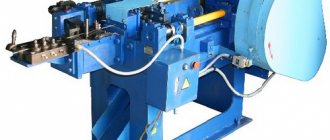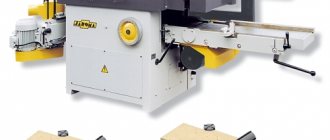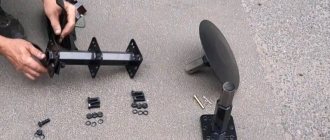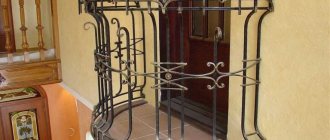The configuration and operational characteristics of sawmill equipment largely determine the success of wood processing production, both large and small, including home-based ones. It would seem that if you take the most expensive and “sophisticated” one, you won’t go wrong. However, it is important for each enterprise to select its own set of equipment that corresponds not only to its scale, but also to the volume of processed raw materials, its properties, and the characteristics of the finished product.
A striking example is the choice of an angle saw. Manufacturers and dealers place emphasis on cutting speed and quality of finished lumber. “You will receive high-quality products with excellent mechanical parameters,” “impeccable lumber geometry,” sounds tempting, doesn’t it? But we must remember that manufacturers are generous with their promises, and statements about the absolute superiority of one technology over another often turn out to be a marketing ploy, nothing more.
Buying equipment, especially unknown equipment, is possible only after a careful analysis of the needs of production and the entrepreneur’s own capabilities. The temptation to purchase a coal saw appears, as a rule, at the stage of modernization of an enterprise. But sometimes beginners also believe that it is better to invest in complex, productive equipment at the start.
Typically, this strategy is chosen by those whose finances allow them not to save. Although the price of the issue makes you think: the cost of a saw blade sawmill is several times higher than the cost of a band sawmill, and the cutting tool for it is not cheap. And this is the case when it is not the stingy person who pays twice, but the too generous one who can irrationally manage his investments.
Is it profitable to purchase an angle saw?
Disc sawmills are traditionally used for the production of edged lumber, parquet, laminated veneer lumber, blanks for molded products, and furniture panels. It is advisable to use charcoal saws for those who work with deciduous and coniferous forests up to 1000 mm in diameter and plan to produce radial lumber from them.
An angle saw is special equipment, and not a general-purpose machine. It is intended primarily for radial cutting of boards. This machine is best suited for those who plan to produce small, specially cut lumber, since it can be used to implement any log cutting pattern.
Boards obtained by radial cutting are often more expensive. Such lumber holds a more stable shape and is less subject to transverse warping when dried than, for example, those obtained as a result of tangential sawing. In addition, they are less susceptible to both swelling and drying out. It is not for nothing that the great Stradivarius preferred to use radially cut wood for his violins.
“Many beginners believe that with one such machine they will be able to export, without having their own timber lease and further deeper processing of wood,” says Andrey Noak, author of a professional blog about woodworking.
But you also need to take into account the productivity of such equipment: the final yield of boards during radial cutting, taking into account all technological features, is up to 35%, and often does not exceed 15%. The characteristics of the raw materials used play an important role: the angle saw cuts wood with a diameter of up to a meter of any curvature and with large branches that conventional sawmills cannot handle. Therefore, the smaller the log, the less such a machine is needed.
How to make it yourself using a circular saw
It is impossible to make a practical corner circular sawmill from a circular saw. Its production is impractical, because the design of such a tool, even if desired, will not allow making deep cuts in logs, which are made in the manufacture of commercial lumber.
In this case, at a minimum, you need to use a conventional electric motor and carry the disk itself on a long shaft.
It is best to make a corner circular sawmill with your own hands, using a 6.5 hp gasoline engine. We recommend watching the corresponding video on how to make such a machine:
In different planes
“It is believed that radial saws are intended only for the production of radial lumber. This is incorrect due to the nature of the miter sawing method itself. It would be correct to say that the method of miter sawing, along with the production of conventional edged lumber, makes it possible to simultaneously produce radial lumber from one log.
The possibility of individual cutting of a log using the angular sawing method allows you to simultaneously obtain radial lumber from defect-free zones of the log and regular edged lumber (but a different cross-section is also possible) from the area of defects. The thickness and width of sawn timber sequentially is limited only by the diameter of the saw blade.
By obtaining at least 20% of radial lumber from raw materials from the total volume of lumber produced, the woodworker significantly increases his profit at the same costs,” says one of the woodworking equipment manufacturers.
What do the users of this equipment—the woodworkers themselves—think? It should be noted that they are rarely ready to openly comment on their experience of working with a particular machine, citing either a lack of experience or certain “related factors” that are different for each wood product manufacturer.
Numerous industry forums become a source of information in this situation - here foresters do not mince words, and if the machine has any shortcomings, they will describe it in the best possible way. But they will not be stingy with praise if there is something to praise for. And at the same time, they will share the problems they encountered when operating this or that model, and their ways of solving them.
For reference, Angle sawing (longitudinal radial cutting of logs using an angular method) is performed on circular saws, when the direction of sawing the disks occurs in two mutually perpendicular planes. This is a new technology in the field of primary wood processing.
This method is simple: circular saws located in the vertical and horizontal planes sequentially cut lamellas from the log, at the end of which the annual rings are located “radially”, that is, at an angle of 45° to the largest plane of the lamella. The log is fixed on the stationary frame of the machine; a portal with a saw unit moves along it along the guides.
Opinions are divided
“An angle saw is a working tool. It is desirable that the possibility of sawing both in angular mode and in camber mode be implemented. Then there will be more opportunities to change the technological chain at different stages of development,” this is how one of the woodworkers spoke about his experience of working with a angle saw on a forestry Internet forum.
His opponent believes that buying an angle saw for camber or other simple cutting is “a crazy investment of money and shooting sparrows with a cannon.”
“I don’t see the point of using it as an alternative to a sawmill frame or a “ribbon”. The installed power is large, the tool is expensive, the machine will not accept crooked hands, the productivity is low. Therefore, when raising the question of for what purposes they buy coal cutting machines, you need to determine these goals for yourself. The first question, of course, will be the availability of suitable raw materials, the second is the availability of a contract under which the sawn products can be sold profitably,” says a sawmill equipment user.
“An angle saw is good when the area is limited and the dimensions of the lumber are close to the dimensions of the beams 100x100x6000, 150x150x6000. That’s when real economic feasibility appears,” his colleague supports.
For reference, radial lumber is used in the production of laminated window timber and supplied to the countries of the European Union.
Introduction
This question is very serious, since, for example, the same ribbon costs 200 thousand rubles, but for example, an angle saw with the same productivity will cost 1.5 - 1.7 million rubles. That’s why I raise this issue, since many novice businessmen, newcomers who have not yet fully understood the sawing technology, begin to “get into deep matters” and in the end do not always get the desired result.
Don’t forget that you can buy good and fresh equipment used, saving enough money. To do this, you just need to go to Avito, for example, and enter a request to find the equipment you need.
The issue of purchasing an angle saw is faced at the following stages:
- Creation of production from scratch, choice of sawing technology;
- Increase in production capacity;
- Shortage of radial lumber;
- Processing of thick wood.
So the main problem is that beginners overestimate information from the Internet and still, before purchasing such expensive equipment, they need very important arguments.
We take into account all factors
What does the area have to do with it? And despite the fact that the use of an angle saw allows you to abandon the machines of the second row: with its help you can get all the edged lumber at once, while after the “ribbon” you will need to install an edger. Therefore, timber merchants recognize the rationality of its use in cases where there is a lack of space on the industrial site.
There is also an opinion that it makes sense to think about purchasing an angle saw for those who have problems with personnel: less equipment means less need for specialists to service it. However, this is not entirely true: the number of workers may be decreasing, but at the same time the requirements for their qualifications are increasing.
“It all comes down to the operator. The value of this frame is much greater than the machine itself. The operator gives you pure money, and he needs to be raised like a child, cared for and cherished. Take care of it like the apple of your eye. You can grow it from scratch. I raised four in a year. First, you will run together with a ruler along the logs, cube, how to saw them, and then the process will begin,” a user of the forest forum with the nickname Oleg shared his experience.
“It’s not easy to find machine operators. The fusion of mechanics and computer technology is difficult for the older generation. Young people have their own problems with learning ability, concentration, and work discipline,” complains another angle saw owner, Evgeniy.
The staff decides
Modern models of such machines are equipped with software and an automatic cutting optimization system, which calculates the optimal log cutting scheme according to the criterion of maximum yield of lumber with specified parameters. However, experienced sawmill managers point out that a qualified operator, having opened a log, can change the cutting combination at any time depending on the presence of knots and internal defects that are not visible from the outside. The computer is not capable of this.
“It’s better to raise an operator on site himself and from scratch. His previous experience of working on a corner of another model is absolutely unnecessary, and sometimes gets in the way. A person gets used to the machine within a month and begins to saw on his own. At a minimum, he must know the structure of wood and its defects, and not just the iron part of the machine.
The operator reaches the design productivity of the machine by the end of the first year of operation. He gains basic experience, learns all the intricacies of sawing, goes through the first mistakes in work, and begins to feel the work of the saw by ear. After all, no one needs a simple “push-button operator” who will chop a mountain of all kinds of noodles from a log,” forum member Oleg continues the recommendations.
Some modern models of angle saws are also equipped with an automatic lumber release system, which allows you to work in a fully automatic mode (when using saw logs of a certain diameter). When removing a sawn board using automatic reset, all manipulations can be done by one operator. Of course, the finished lumber will not fall into his hands on its own, but it will be dumped in a fairly compact area.
In the absence of such a system, the productivity of the equipment directly depends on the efficiency of the operator’s assistants. As a rule, two assistants carry the boards a decent distance, trim them if necessary and place them in bags. The operator waits until they move to a safe distance, and only then starts a new sawing cycle. Accordingly, the difference between removing material manually and automatically resetting is significant.
Flaws
I would list the following as the disadvantages:
- Since this is a disk, the yield of lumber will fall compared to a strip;
- More waste;
- High cost of equipment, the machine is 6 times more expensive than its competitor, the ribbon;
- More expensive cutting tool. A saw for a disk, depending on the size, will cost from 10 to 15 thousand, while a saw for a ribbon can be found for 500 rubles.









